Basic transformations
Let’s show some SpectroChemPy features on a group of IR spectra
[1]:
import spectrochempy as scp
from spectrochempy import MASKED
from spectrochempy import DimensionalityError
from spectrochempy import error_
|
|
SpectroChemPy's API - v.0.8.2.dev24 ©Copyright 2014-2025 - A.Travert & C.Fernandez @ LCS |
Running on GitHub Actions
MPL Configuration directory: /home/runner/.config/matplotlib
Stylelib directory: /home/runner/.config/matplotlib/stylelib
[2]:
dataset = scp.read_omnic("irdata/nh4y-activation.spg")
dataset.y -= dataset.y[0]
dataset.y.title = "time"
dataset
[2]:
NDDataset: [float64] a.u. (shape: (y:55, x:5549))[nh4y-activation]
Summary
Omnic filename: /home/runner/.spectrochempy/testdata/irdata/nh4y-activation.spg
2025-12-28 02:02:37+00:00> Sorted by date
Data
[ 2.033 2.037 ... 1.913 1.911]
...
[ 1.794 1.791 ... 1.198 1.198]
[ 1.816 1.815 ... 1.24 1.238]] a.u.
Dimension `x`
Dimension `y`
[ vz0466.spa, Wed Jul 06 21:00:38 2016 (GMT+02:00) vz0467.spa, Wed Jul 06 21:10:38 2016 (GMT+02:00) ...
vz0520.spa, Thu Jul 07 06:00:41 2016 (GMT+02:00) vz0521.spa, Thu Jul 07 06:10:41 2016 (GMT+02:00)]]
[3]:
prefs = scp.preferences
prefs.figure.figsize = (6, 3)
prefs.colormap = "Dark2"
prefs.colorbar = True
ax = dataset.plot()
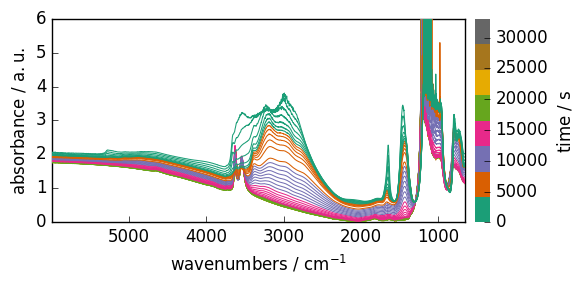
Masking data
if we try to get for example the maximum of this dataset, we face a problem due to the saturation around 1100 cm\(^{-1}\).
[4]:
dataset.max()
[4]:
One way is to apply the max function to only a part of the spectrum (using slicing). Another way is to mask the undesired data.
Masking values in this case is straightforward. Just set a value masked or True for those data you want to mask.
[5]:
dataset[:, 1290.0:890.0] = MASKED
# note that we specify floating values in order to sect wavenumbers, not index.
Here is a display the figure with the new mask
[6]:
dataset.plot_stack()
[6]:
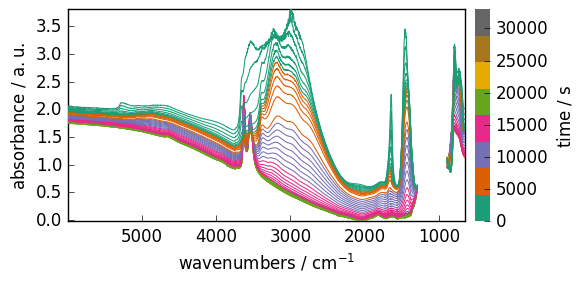
Now the max function return the maximum in the unmasked region, which is exactly what we wanted.
[7]:
dataset.max()
[7]:
To clear this mask, we can simply do:
[8]:
dataset.remove_masks()
dataset.plot()
[8]:
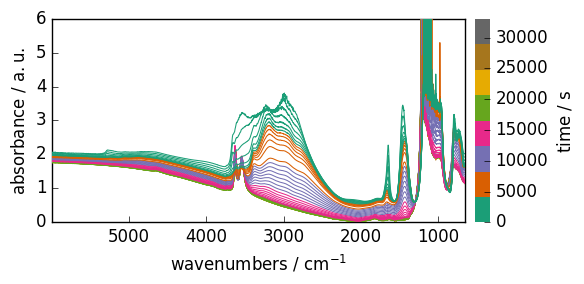
Transposition
Dataset can be transposed
[9]:
dataset[:, 1290.0:890.0] = MASKED # we mask the unwanted columns
t_dataset = dataset.T
t_dataset
[9]:
NDDataset: [float64] a.u. (shape: (x:5549, y:55))[nh4y-activation]
Summary
Omnic filename: /home/runner/.spectrochempy/testdata/irdata/nh4y-activation.spg
2025-12-28 02:02:37+00:00> Sorted by date
2025-12-28 02:02:39+00:00> Data transposed
Data
[ 2.061 2.037 ... 1.791 1.815]
...
[ 2.013 1.913 ... 1.198 1.24]
[ 2.012 1.911 ... 1.198 1.238]] a.u.
Dimension `x`
Dimension `y`
[ vz0466.spa, Wed Jul 06 21:00:38 2016 (GMT+02:00) vz0467.spa, Wed Jul 06 21:10:38 2016 (GMT+02:00) ...
vz0520.spa, Thu Jul 07 06:00:41 2016 (GMT+02:00) vz0521.spa, Thu Jul 07 06:10:41 2016 (GMT+02:00)]]
As it can be observed the dimension xand yhave been exchanged, e.g. the original shape was (x: 5549, y: 55), and after transposition it is (y:55, x:5549). (the dimension names stay the same, but the index of the corresponding axis are exchanged).
Let’s visualize the result:
[10]:
t_dataset.plot()
[10]:
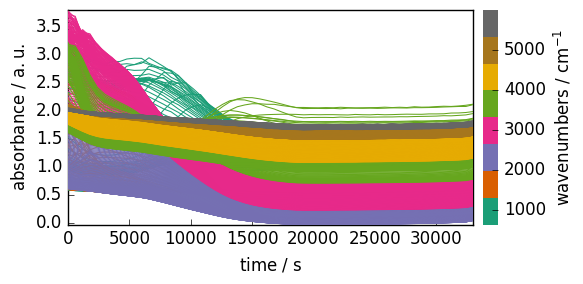
Changing units
Units of the data and coordinates can be changed, but only towards compatible units. For instance, data are in absorbance units, which are dimensionless (a.u). So a dimensionless units such as radian is allowed, even if in this case it makes very little sense.
[11]:
dataset.units = "radian"
[12]:
dataset.plot()
[12]:
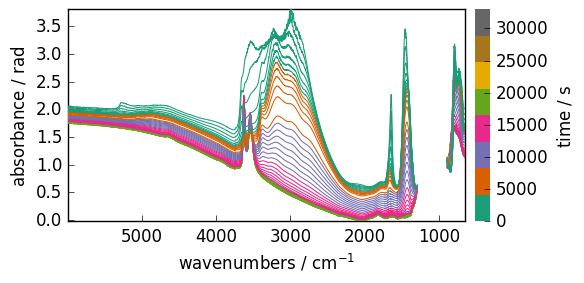
Trying to change it in ‘meter’ for instance, will generate an error!
[13]:
try:
dataset.to("meter")
except DimensionalityError as e:
error_(DimensionalityError, e)
ERROR | DimensionalityError: Cannot convert from 'radian' (dimensionless) to 'meter' ([length])
If this is for some reasons something you want to do, you must for the change:
[14]:
d = dataset.to("meter", force=True)
d.units
units forced to change
[14]:
When units are compatible there is no problem to modify it. For instance, we can change the y dimension units ( Time) to hours. Her we use the inplace transformation ito .
[15]:
dataset.y.ito("hours")
dataset.plot()
[15]:
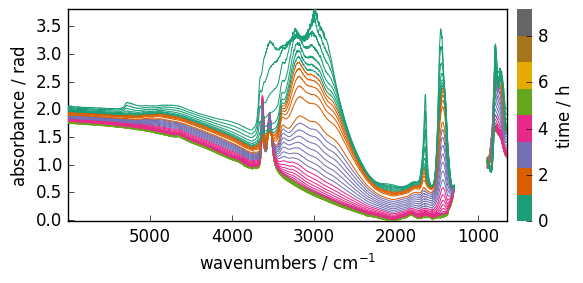
See Units for more details on these units operations